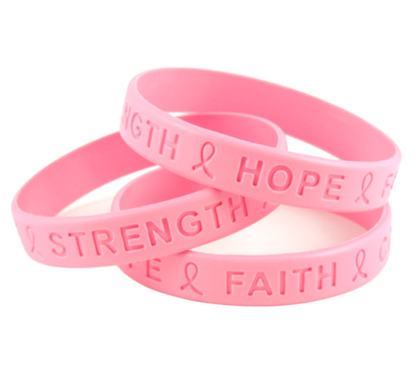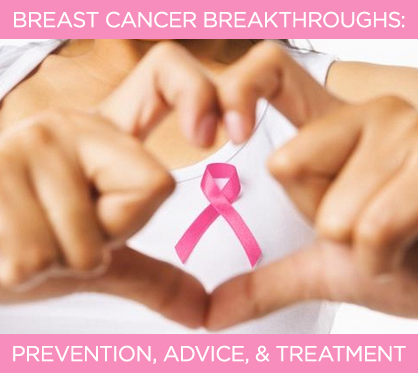Going Pink for Prevention: Breast Cancer Breakthroughs
The color pink dominates in October, and with good reason, since this is National Breast Cancer Awareness month. Races, fundraisers and other events are happening nationwide all month to help support this noble cause. To find out about events in your area, visit the Susan G. Komen website for more information.
Breast cancer doesn’t discriminate. It can affect anyone. Even men. Find out if you’re at risk and where the best hope lies in the latest research. Our experts talked to us to share their tips and advice on prevention and treatment.

Prevention:
Barry Sears, M.D., who popularized The Zone Diet, is a leading authority on the impact of the diet on hormonal response, genetic expression, and inflammation. He said that anti-inflammatory diet is the best possible preventative approach.
“Elevated levels of insulin is a growth factor for breast cancer. Therefore reducing insulin resistance is a primary dietary strategy. This means eating a lot of non-starchy vegetables, limited amounts of fruits and very little, if any, grains or starches. This is a low-glycemic load diet,” Sears said. “The carbohydrates should be balanced at every meal with no more low-fat protein (fish, chicken, or vegetarian choices) that can fit on the palm of your hand. The diet should be a low fat diet, but one that is rich in omega-3 and monounsaturated fats, and very low in omega-6 fats (because they drive inflammation).”
Food has such an impact on cancer prevention because, Sears said, “Food generates hormonal responses, and breast cancer is especially prone to disturbances in hormonal balance.”
As for vitamins and supplements, Sears recommends omega-3 fatty acids. “Several clinical trials have demonstrated that high intake of omega-3 fatty acids dramatically alter the inflammatory composition of the fatty tissue in the breast. This reduces the likelihood of inflammation in that organ.”

Statistics & Research:
According to the American Cancer Society, breast cancer is the most common cancer among women in the United States, other than skin cancer. It is the second leading cause of cancer death in women, after lung cancer. According to the 2010 breast cancer demographics there are:
• Approximately 207,000 new cases diagnosed each year
• Of the 207,000 new cases, about 54,000 are non-invasive forms of breast cancer that have been diagnosed early
• Approximately 40,000 deaths related to breast cancer in women, annually
The National Cancer Institute includes a breast cancer risk calculator on its website to help women know if they’re statistically more likely to develop the disease.
Elizabeth Chabner Thompson, M.D., MPH radiation oncologist and the founder of BFFL Co., said the people most at risk for developing breast cancer are, “Women with a family history of breast and ovarian cancer. Women who have had radiation to the chest in childhood (to treat another cancer, for example); women with inherited gene mutations such as BRCA, P-10; Li-Fraumeni syndrome and others. Just because a woman tests negative for the BRCA genes does not mean that the “family” does not carry some other gene mutation that elevates risk. All of this should be discussed with a genetic counsellor.”
Thompson said, “If your family history includes breast or ovarian cancer, be sure to discuss this with your physician. Testing for identifiable breast cancer genes is way to gain information to make informed decisions. By knowing your medical history and your family history, there are several inherited diseases that can be recognized that increase a woman's risk of breast cancer. If a woman is at high risk for breast cancer, there are surveillance strategies, hormonal therapies and surgical interventions to reduce risk.”
There is hope on the horizon as progress continues to be made in researching the cause and prevention of breast cancer. “There is continual progress in all areas of breast cancer treatment. From identifying women at risk, determining optimal treatment based the molecular level to through novel surgical and radiation techniques to new drugs, hormonal treatments and even anti-body/vaccine therapy. It's a very exciting time on all fronts,” Thompson said
Early detection is an important step in curing breast cancer. The Susan G. Komen website includes helpful diagrams of potential problems. Remember, the warning signs for breast cancer are not the same for all women. The most common symptoms are a change in the look or feel of the breast, a change in the look or feel of the nipple and nipple discharge. Monthly breast self-exams are also an important step.
Thompson said the single most important piece of advice she can give to women is, “Know your body - know what feels normal and what feels different. Don't be afraid to seek medical attention. Early detection and diagnosis leads to a cure in close to 99 percent of patients.”
Read more Breast Cancer Awareness
Tagged in: wellness, health, breast cancer awareness, cancer,

LadyLUX



